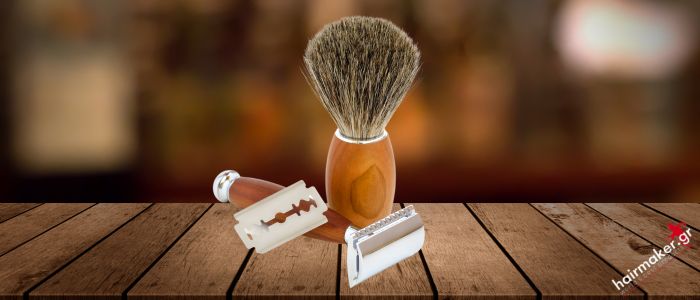- HairMaker.Gr
- Traditional Shaving
- 0 likes
- 4027 views
- 0 comments
- aftershave, traditional shaving, Shaving, after shaving, before shaving, how to shave
Everything for before and after shaving
Before shaving
In order to achieve the best and most comfortable shave, it is necessary to properly prepare your face. Poor shaving preparation is one of the most common reasons for skin irritation.
Just a few minutes of pre-shave preparation can transform your shaving results.
Warm water
The essential part of any pre-shave procedure is hot water. Hot water softens the beard, making it easier to cut, and it also cleanses the skin and removes dead cells that may be present around the beard hairs.
Shaving immediately after a hot shower, applying a towel soaked in hot water or simply putting hot water on your face for a minute or two are all easy ways to soften your beard.
Using a daily exfoliator during this process will further help remove all the dead cells and allow the warm water to penetrate the beard and skin.
Pre-Shave Balm and Lotion
For particularly stiff hairs it is recommended to use pre-shave balm or lotion to speed up and increase the softening effect on beard hair. These are usually applied to the beard area and then left for a minute or two to do their job - this is a good time to move on to something else, such as prepping your shaving cream.
The pre-shave products can then be rinsed off or you can apply the shaving foam directly on top if you prefer.
Pre-Shave Oil
Pre-shave oil can have a softening effect on the beard but can also help provide additional lubrication for better razor glide during shaving. Apply before shaving foam.
For those who are not experienced in shaving we recommend paying close attention to preparation and doing as much as possible to ensure the best shave.
When you achieve the correct shave without irritation then you can start to reduce the pre procedure if you feel you need to.

Here are some tips to keep in mind during shaving
Maintain a steady hand:
Hold the razor with a firm grip but avoid applying too much pressure. Allow the weight of the razor to do the work and let it glide gently over your skin.
Use short, gentle strokes:
Instead of long strokes, use short and precise strokes. This helps to maintain control and reduce the risk of cuts or nicks.
Stretch the skin:
Use your free hand to gently stretch the area you're shaving. This helps to create a smoother surface and allows the razor to glide more easily.
Rinse the razor frequently:
Rinse the razor under running water after every few strokes to remove any built-up hair, shaving cream, or debris. This ensures a cleaner and more effective shave.
Avoid going over the same area repeatedly:
Over-shaving can lead to irritation and razor burn. If you need to go over a particular area again, reapply shaving cream before doing so.
Be cautious around sensitive areas:
Take extra care when shaving sensitive areas like the neck, jawline, or bikini area. Use light pressure and slow, gentle strokes to minimize irritation.
Check the direction of hair growth:
Pay attention to the direction in which your hair grows. Shave with the grain for the first pass, and only consider going against the grain if necessary and if your skin can tolerate it.
Cleanse and moisturize when needed:
If you're shaving a larger area or have multiple passes, you can periodically rinse your skin with warm water to remove excess shaving cream and then reapply a thin layer before continuing. After shaving, rinse with cold water to close the pores, pat your skin dry, and apply a moisturizer to keep your skin hydrated.
Remember to be patient and take your time while shaving. Rushing can increase the likelihood of cuts and irritation. Listen to your skin and adjust your technique accordingly for a comfortable and smooth shaving experience.
After shaving
After shaving, your skin can remain vulnerable and exposed and it is important to treat it properly to keep it fresh throughout the day.
The first thing to do is to rinse your face with warm water to clean any residual shaving cream from the skin. When the skin is completely clean, you should rinse your face with very cold water. The cold water will help to tighten the open pores, stop any small blood spots that may be present and thus the skin will start to calm down.
It is very important to gently dry your face with a towel and not rub it, as rubbing it with a towel can cause irritation.
Aftershave splash
Aftershave splash is a liquid, often with alcohol, that has antiseptic and astringent properties to calm and nourish the skin after shaving. Splashes are popular with men who have oily skin or live in hot countries. They are usually heavily scented.
Aftershave balms
An aftershave balm after drying has a stronger consequence than a splash. It is more moisturizing and provides more relief from irritation. Aftershave balms are especially good for the winter months when cold air can dry out the skin.






Comments (0)